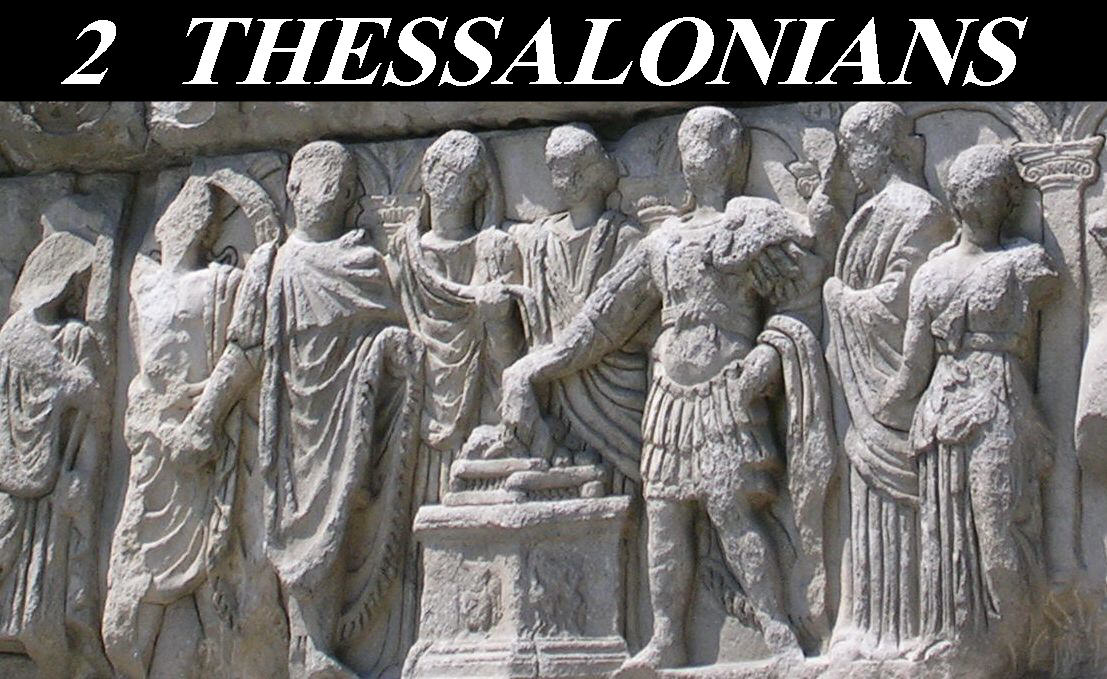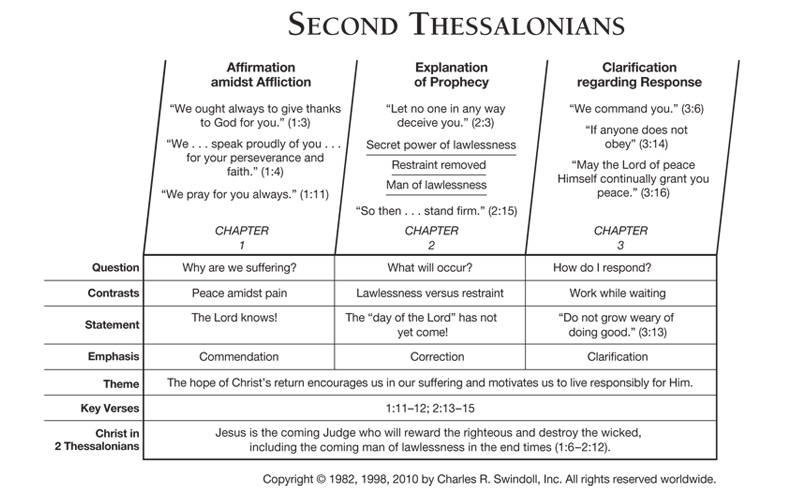2 THESSALONIANS AN INTRODUCTION

A COMMENTARY DEVOTIONAL STUDY OF
2 THESSALONIANS
AN INTRODUCTION
By Michael K. Farrar, O.D.
© God’s Breath Publications
Biblical devotionals, if properly done, are very helpful to us in growing spiritually and living out our faith. But they are only as good as they are applied to our everyday lives. Charles Swindoll says it this way,
“Knowledge apart from application falls short of God’s desire for His children. He wants us to apply what we learn so that we will change and grow.”
In order to grow spiritually, our first step is to know more of the Word of God (2 Timothy 2:15). Our spiritual faith grows because our knowledge of the Word grows and therefore we have a greater confidence in our Heavenly Father and our trust in His sovereignty over our lives increases. As we seek to apply what we know of His Word we see an increase in our obedience to His instruction which demonstrates our love for God (John 14:15). As we continue to apply what we learn we walk as Jesus walked (1 John 2:6) and keep in step with the Holy Spirit more consistently (Galatians 5:25). Out of this we see a godly joy that is present, even in trials and tribulations (1 Thessalonians 1:6).
In this devotional series I hope to both encourage you in your relationship with God, but also challenge you to apply what you learn from God’s Word. The New Testament book of James commands us to be doers of the word. In other words, we MUST APPLY what we read and learn if we are to fulfill our calling, our responsibility as followers of Jesus Christ.
James 1:22-25
“Prove yourselves doers of the word, and not merely hearers who delude themselves. For if anyone is a hearer of the word and not a doer, he is like a man who looks at his natural face in a mirror; for once he has looked at himself and gone away, he has immediately forgotten what kind of person he was. But one who looks intently at the perfect law, the law of liberty, and abides by it, not having become a forgetful hearer but an effectual doer, this man will be blessed in what he does.”
So to help you learn and apply what is beneficial to your spiritual growth I would encourage you to approach this devotional study with a commitment to observe these five steps.
First, pray before you read the scripture, that you will seek to both understand and apply what you learn.
(Psalms 119)
Second, read the scripture passage with a passion and a desire to be convicted by what you read.
(Psalms 37:29-31)
Thirdly, seek to meditate and absorb what you read and respond to how the Holy Spirit will convict you to act.
(John 16:13-15)
Fourthly, challenge yourself how you might apply the convictions that come from the scripture and the Spirit.
(Psalms 1:1-3)
Fifthly, pray once again, that you will consistently act upon what the Holy Spirit is prompting you to do.
(James 1:22-25)
Soon after Paul wrote 1 Thessalonians he sent a second letter.
This letter, while written in the third century, could reflect the witness of the followers of Christ in any area of the known world where Christians lived in the first century. They were enduring persecution with a strong faith and joy. While they were imperfect people, they understood they were forgiven by God, saved by grace and compelled to live for their Savior and Lord, Jesus Christ. May we be known in our lives as the Thessalonian Christians were, as a quiet and holy people, dedicated to love others and living as Jesus Christ would in today’s world. My hope is that as you apply yourself to this devotional series, you will not only expand your knowledge of God’s Word and in how to apply this knowledge to your everyday life, you will also draw closer in your relationship with the Holy Spirit, Jesus Christ and your Heavenly Father.
2 Thessalonians – An Introduction
As I mentioned concerning 1 Thessalonians, Paul and his companions, Silas and Timothy, visited Thessalonica in about 49 or 50 A.D. 2 Thessalonians was written probably in Corinth by Paul to follow his first letter, possibly within a few months and at least within less than a year of the first letter. False teachers and critics of Paul were continuing to speak against true Christian beliefs and were also spreading rumors about Paul. Timothy had reported in 1 Thessalonians that there were critics of Paul in the church (1 Thessalonians 2:2-6, 2:17-3:5). There is even speculation that possibly forged documents were being passed around among Christians that claimed to be writings from Paul when they were not. 2 Thessalonians 2:2-3 hint to the fact that the Thessalonians were being given letters or documents that had Paul’s signature on them. This may be the reason that Paul ends 2 Thesssalonians with the following, 2 Thessalonians 3:17-18, “I, Paul, write this greeting with my own hand, and this is a distinguishing mark in every letter; this is the way I write. “ Here he is possibly identifying the style and type of writing he does so the followers of Christ at Thessalonica can recognize letters from him compared to false documents spread by false teachers and Jews who did not like Paul’s teachings nor the Christian faith.
Paul, a great encourager, desired to uphold the followers of Christ at Thessalonica by sending another letter to further bolster their faith and their deep resolve to live for Christ despite intense persecution. Paul also wished to continue his correction and instruction of the Thessalonian Christians in all areas of Christian living as well as being prepared for the second coming of Jesus. He also desired to give them instruction in how to handle lazy Christians. We could compare 1 and 2 Thessalonians by saying that Paul wrote the 1 Thessalonians primarily to comfort the Thessalonians, where he wrote 2 Thessalonians mostly to correct them. First, he wanted to assure his fellow believers of his love and concern for them. Secondly, Paul’s enemies were continuing to attack his character and he wanted to set the record straight as to their false accusations. Paul also wanted to ground the followers of Christ in Thessalonica in the doctrines of the Christian faith, especially in reference to the return of Christ. He also wanted to encourage them during the intense persecution they were under because of their faith. He wanted to persuade them to live holy lives even though they were surrounded by a perverse and wicked culture. Finally, he wanted to correct weaknesses in the church regarding disrespect for spiritual leaders, believers who were refusing to work because they thought Christ would return soon and the confusion in their worship services that needed correcting.
The book of 2 Thessalonians demonstrates to us that while history has marched on, the issues that people face in their faith, as it is applied to life, has not changed. We can learn a great deal from this letter Paul wrote to the followers of Christ in Thessalonica. As we saw in 1 Thessalonians, almost every major doctrine of the Christian faith is mentioned in 2 Thessalonians as well. The special blessing you will receive studying 2 Thessalonians is that the message of the return of Jesus Christ is a vital doctrine that affects how we live as Christians today.
As always, while you read this short book (it takes only about 9 minutes to read), the Holy Spirit will illuminate scripture and you will see where you need to trust more in your Heavenly Father, where you need to apply scripture to an neglected area of your life, where you need to repent of a sin, when you will need to ask for forgiveness from someone or to forgive someone who has offended you. You will also receive encouragement from the Spirit when you obey the instruction from the Lord contained in this little book of the Bible. The Holy Spirit will show you how you have grown in areas of your spiritual life. He will also demonstrate to you how you bring God glory through your witness and commitment to your Lord and Savior, Jesus Christ.
In the next segment of this series I will present you with the first 7 days worth of devotions for 2 Thessalonians. Before you proceed, I would encourage you to read through the entire book of 2 Thessalonians taking note of concepts, thoughts and ideas that are contained within it. Attempt to think about the book in its entirety so that when you begin your devotions you have a broad base of understanding of what it contains. Also, pray expectantly for God to work in your life, as you prepare to begin the journey of not only discovering the truth contained in this book of the Bible, but also what the Holy Spirit wishes to teach you so that you can apply it to your everyday life. Following are some aides for your devotional study of the book of 2 Thessalonians.
Here is a map showing the location of Thessalonica.

Basic concepts of the chapters of 2 Thessalonians
The first chapter instructs us how to glorify God in our Persecutions, Afflictions and Tribulations.
The second chapter encourages us to Trust God in the midst of Confusion.
The third chapter relates our Salvation to our Service while we Wait for the Lord’s coming.
Below is an outline by Charles Swindoll concerning the content and structure of 2 Thessalonians. It very likely will prove useful as you proceed through this devotional series.
